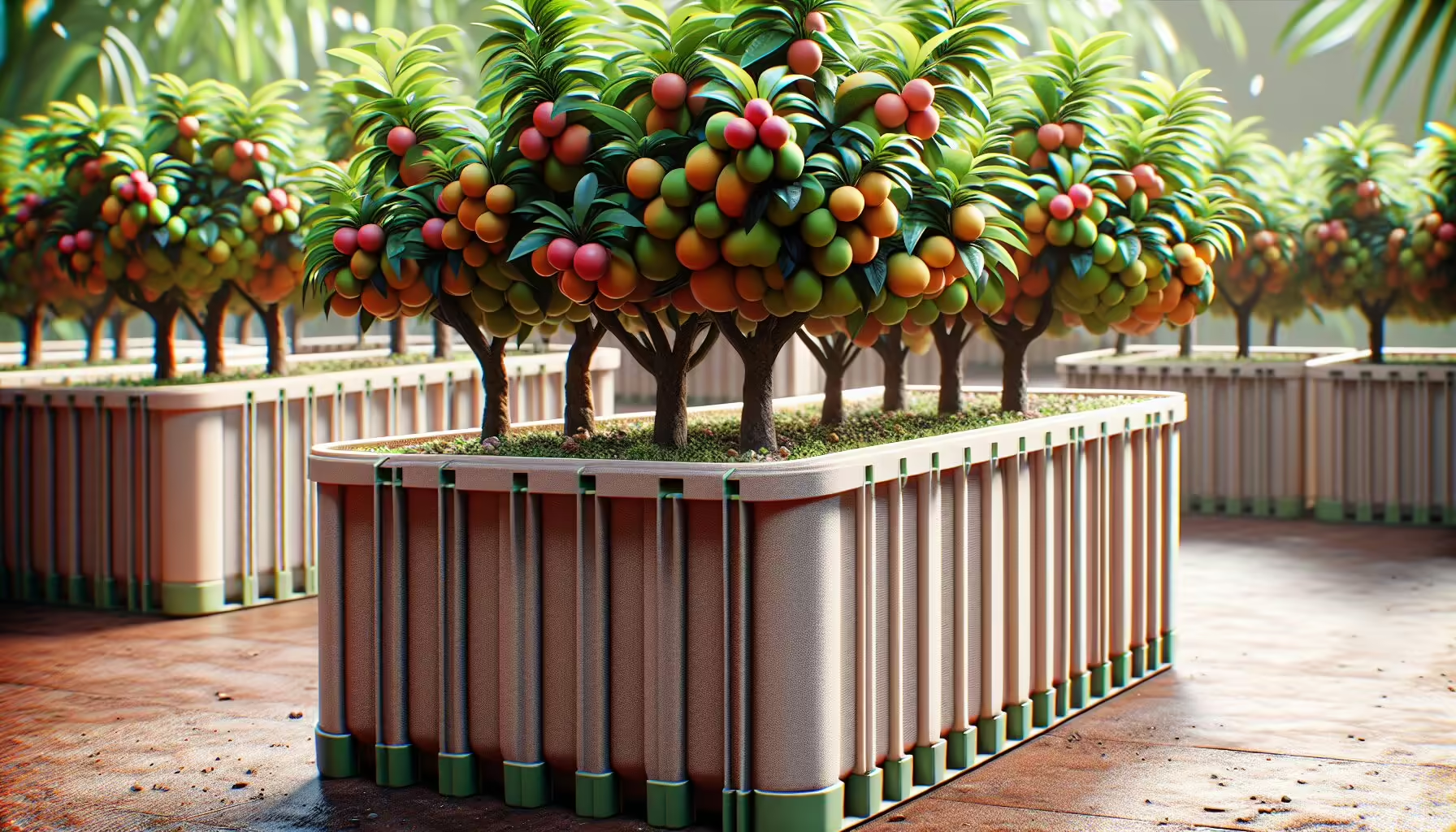Thriving with Elegance: The Beauty of Column Fruit Trees
Choosing Columnar Fruit Trees
If you’re like me and short on space but big on dreams, picking the right columnar fruit trees can make all the difference. Let’s walk through some top fruit picks for these slender growers and what you should think about when space is tight.
Ideal Fruit Varieties
First things first: you gotta pick the fruit that works best for what you need—and where you live. Here are a few fruity celebs that are making waves in tight spots:
Apple Varieties: Meet the ‘Ballerina’ and other columnar champs—they’re like the giraffes of apple trees. Tall, slim, and neat, they’re perfect for squeezing into tiny yards (Vocal Media).
Pear Varieties: Columnar pears are a go-to for pear lovers trapped in a postage-stamp garden. They’re all about that vertical life, sprouting up without a fuss.
Cherry Varieties: Check out the ‘North Star’ and ‘Stella’ cherries—pretty blossoms in spring, tasty bites in summer, all packed into a skinny frame.
Here’s a quick peek at how these columnar fruit tree varieties stack up:
| Fruit Tree | Variety | Vertical Height (ft) | Spread Width (ft) | Noteworthy |
|---|---|---|---|---|
| Apple | ‘Ballerina’ | 8-10 | 2-3 | Early fruit action, low maintenance |
| Pear | ‘Columnar Bartlett’ | 10-12 | 3-4 | Fast fruiting, tough against diseases |
| Cherry | ‘North Star’ | 6-8 | 3-4 | Compact and self-reliant |
Considerations for Limited Spaces
Columnar fruit trees are like the superheroes of small spaces—tall, lean, and ready to save your day. Here’s what I’ve learned from trying to squeeze as much as possible into my little patch of green:
Tiny Spaces: Thanks to their upright growth, these trees fit into places like patios, balconies, or those oh-so-useful raised beds. They make the most of vertical room and don’t clutter your horizontal vibe (GardenWeb).
Container Growth: Many of these columnar marvels love life in a pot. So, urban gardeners rejoice! Big enough to keep roots cozy and small enough to scoot around when you need to (Growing Columnar Fruit Trees in Containers).
Minimal Pruning: The less work, the better, right? These trees keep it simple. Let the main stem grow tall and snip the side shoots to three buds for a neat setup (Gardening Theme). Need more snipping tricks? We’ve got a pruning guide with the scoop.
Healthy Dirt and Food: Want healthy trees? They need good, well-drained dirt and a bit of plant food. Keep an eye on moisture and nutrients to keep them happy. Check out our tips on container fruit trees for the dirt on dirt.
City Gardening: Perfect for turning gray city corners into green paradises. They fit snug on a balcony or can create a leafy divider in urban gardens. Their vertical savvy means they pair well with any vertical gardening dreams you have.
Getting the right columnar fruit trees is a game of using your space wisely and picking the varieties that hit the spot. With the right fruit picks and a little TLC, you can have a bustling and beautiful garden, even when the square footage is more “cozy apartment” than “grand estate.”
Benefits of Columnar Apple Trees
Early Fruit Production
Guess what? Columnar apple trees don’t mess around—they’re eager beavers when it comes to sprouting delicious apples right out of the gate. Imagine planting your tree and chomping on its fruit just a year later! This not only gets your taste buds dancing early but also makes it a no-brainer for folks who want their gardens to pay off fast (Fine Gardening).
Here’s how they stack up against your regular apple trees:
| Tree Type | Fruit Ready In |
|---|---|
| Columnar Apple Trees | 1 Year |
| Traditional Apple Trees | 2-4 Years |
For those living with less elbow room, columnar trees are like a dream come true. They fit right into tight spots, like those cool container fruit trees on your porch or adding flair to your patio fruit trees lineup. Want more quick-bearing options? Cruise over to our miniature fruit trees guide.
Cross-Pollination Importance
So, here’s the deal. If you want juicy apples, you’ve gotta think about cross-pollination—it’s the secret handshake between trees that keeps the fruit party going. Thanks to their straight-up-and-down growth, columnar apple trees know how to keep the pollen flowing by being close neighbors.
Planting two tree varieties nearby that sync up their blooms is the way to go. They’ll help each other out, ensuring a bushel of apples. Check out these matchups:
| Variety | Pollinator Partner |
|---|---|
| Golden Sentinel | Scarlet Sentinel |
| Sonet | Rondo |
Grasping the ins and outs of cross-pollination sets you up for a bumper crop. If you want to mix things up, exploring pleached fruit trees and espalier fruit trees might just be your next adventure.
Getting those tasty apples sooner and playing the pollination game right makes columnar apple trees an ace choice. Eager for more tips on small garden setups? Check out what we have on small fruit trees.
Popular Columnar Apple Varieties
Alright, let’s get our hands dirty and talk about apple trees. Yep, specifically those neat columnar kinds that fit right into a cozy corner of your garden without demanding all your space like a drama queen. Whether you’re dreaming of applesauce or a juicy snack straight from the tree, knowing the ins and outs of these apple divas will help you snag the right one for your fruit tree garden.
Flavor Profiles
Picking the right apple tree isn’t just about looking good (though it helps); it’s about tickling those tastebuds too. Check out these flavor-packed contenders:
| Apple Variety | Flavor Profile | Description |
|---|---|---|
| Northpole | Sweet-tart | Think McIntosh apples on a strict diet! They’re sweet, with just the right tang. |
| Golden Sentinel | Sweet, mellow | Like a mellow jam band version of Golden Delicious, these are sunshine on a stick (Bright Lane Gardens) |
| Scarlet Sentinel | Sweet-tart | Picture green-yellow apples with a cheeky red blush (Fine Gardening) |
| Blushing Delight | Sweet-tart | Medium, blushy fruits that could win Miss Apple Universe (Bright Lane Gardens) |
| Crimson Columnar | Crisp, tangy | Deep red beauties ready for an audition in your favorite pie (Bright Lane Gardens) |
Planting Requirements
Want those apple trees to stand tall and proud? Better listen up to their growth gossip:
- Soil: These trees are picky eaters; they love well-drained soil filled with rich, organic goodies. Avoid soggy messes.
- Sunlight: Aim for a sunbathing sesh of six hours plus. The more rays, the merrier those apples will grow.
- Watering: Regular but not drowning. These trees like their thirst quenched, especially when they’re gearing up for growing.
- Support: Thanks to their sky-reaching ambition, they might need a little help standing up straight. Bring in those stakes to stop them from face-planting.
Give the right kind of love and these trees will thank you with bountiful apple harvests. If you want the secret sauce on keeping them happy, don’t forget to check out our tips on proper support and care.
Ready to become an apple whisperer? We’ve got more nuggets on container fruit trees and small fruit trees to keep your garden buzzing with flavor. Learn your apples inside and out, and you’ll be rewarded with tasty, home-grown goodness.
Maintenance Tips for Columnar Fruit Trees
Taking care of columnar fruit trees isn’t rocket science, but you gotta pay attention to the details. Here’s how to keep your skinny fruit buddies happy and bountiful.
Pruning Guidelines
Snipping away at your trees might sound drastic, but it’s your ticket to hardy, fruity success. Pruning wakes up those sleepy buds, turning them into a sprouty party, making your tree that much happier (Stark Bro’s). Plus, a good prune keeps your tree balanced, like a fruit-bearing acrobat.
- When to Prune: Prune when your tree’s taking its nap — in the late fall, winter, or early spring, depending on your local climate. No leaves mean you can get a clear view of what to chop (Stark Bro’s).
- How to Prune: For columnar types, let that main central branch run wild, but trim those side sprouts down to three buds for each shoot. Try to catch these wild shoots in summer, particularly if you’re dealing with columnar apples or pears (Gardening Theme).
Proper Support and Care
Keeping your columnar fruit trees upright and bubbly isn’t a chore if you’re consistent.
- Support Structures: These trees often need a little extra help staying upright, especially when they’re young and overloaded with juicy fruits. A good stake or a trellis does the trick.
- Repotting: Around the four-year mark, it’s time to give your tree a new pot or fresh compost to munch on. Container-bound trees, especially, thrive on this change-up (Chris Bowers & Sons).
- Feeding and Watering: Your tree loves a steady diet and drink, especially when fruiting. Break out the balanced fertilizer and keep the water coming. Your tree will thank you with a fruity bounty.
If you want the 411 on other fruity households, check out our section on fruit tree garden — there’s also stuff on patio fruit trees and those neat cordon fruit trees.
Stick to these tips and your columnar fruit trees will repay you with a never-ending supply of deliciousness year after year. For guides on keeping espalier or even miniature fruit trees in line, we can hook you up.
Growing Columnar Fruit Trees in Containers
Columnar fruit trees are like the skyscrapers of the tree world—tall, slim, and perfect for tight spaces. If you’re short on square footage, but big on dreams of homegrown apples, pears, plums, or cherries, knowing how to pamper these little giants in pots is your ticket to a fruitful bounty.
Container Requirements
Picking the right pot is half the battle in successfully raising container fruit trees.
| What You Need to Know | Details |
|---|---|
| Size | Go for at least 20-liter buckets |
| Material | Clay or plastic with drainage pipes please |
| Soil | Think loam-based gumbo |
| Drainage | Excellent drainage is your root rot insurance |
These trees can happily live in 20-liter digs for ages and love a repot with fresh loam-based compost every four years. Some helpful insights from Chris Bowers & Sons can take you a long way.
Watering and Fertilization Tips
Water and fertilizers are like coffee and breakfast—essential for getting your columnar trees ready for the day (or season).
Watering:
Keep these sippers happy, particularly from April to October when they’re most thirsty. Here’s a little chart to keep you on track:
| Season | How Often to Water |
|---|---|
| Spring to Summer | Keep it wet, but not swampy |
| Autumn | Ease up a bit |
| Winter | Bare minimum, but don’t let it become a desert |
Fertilization:
Their hunger for nutrients is real, so make sure they’re well-fed to boost growth and harvest.
- Type of Fertilizer: Seaweed juice or slow-release pellets are top contenders.
- Application: Feed throughout the growing months for the best results.
Slow-release fertilizer tablets are a busy gardener’s dream. A good feeding schedule, especially when the fruits appear, is your best bet for a bumper crop as recommended by our friends at Chris Bowers & Sons.
Stick to these simple pointers, and you’ll be swimming in fresh fruit from your potted trees in no time. Want more tree-growing magic tips for limited spaces? Check out our pieces on patio apple trees and miniature fruit trees.
Packing a Punch with Columnar Fruit Trees
Need a lush, fruit-bearing buddy but short on space? Columnar fruit trees are here to save the day! These skinny wonders fit snugly into tight areas while still delivering the fruity goods.
City Life, Fresh Fruit
City living ain’t gotta mean skipping out on homegrown fruit goodness. If you’ve got a balcony or terrace, these trees are your jam. They grow straight up like a beanpole, perfect for tight spots. Columnar trees can comfortably live in a pot and are all the rage among city folks who want to embrace their inner farmer without moving to the countryside.
City-Slickin’ Ideas:
- Balconies and Terraces: An easy way to sprinkle some green and grab some fresh fruit on your morning routine.
- Living Partitions: Need a little nook? Set up these trees close together for a bit of privacy without building a wall.
For more about caring for your potted fruit buddies, swing by our patio fruit trees guide here.
Planting Possibilities Galore
These columnar champs can be more than just city heroes. Their tidy size makes them a landscaper’s dream, offering a bunch of cool ways to jazz up your garden.
Flexible Ideas:
- Fruit-Fence or Screen: Line ’em up for a fence that’s not just good-looking but gives you privacy too.
- Fruitful Arches: Imagine strolling under an archway of these beauties. Talk about garden goals!
- Mix and Match Borders: Pair them with flowers for a blend of color and a fruit surprise.
- Wall and Fence Climbers: Against a wall, these trees grow upright, saving you ground space and turning plain walls into a feast.
Check this table for more ways to spice up your space with columnar fruit trees:
| Planting Spot | What’s Great About It |
|---|---|
| Balcony/Terrace Pots | Squash ’em into tight spaces with room to thrive |
| Living Partitions | Green dividers that don’t need bricks |
| Fruiting Fence/Screen | Rows for privacy, beauty, and juicy rewards |
| Fruitful Arches | Dress-up your space with fruit-laden arches |
| Mix & Match Borders | Blend flowers and fruit for some garden pizazz |
| Wall/Fence Planting | Growing up, not out, against boundaries |
Want more creative green ideas? Peek at our articles on espalier fruit trees and pleached fruit trees.
Columnar fruit trees offer a savvy way to ditch the space war, keeping your green thumb happy and hands full of fresh fruit. Explore more space-saving garden tactics with guides on potted lime tree and patio cherry tree.




Post Comment